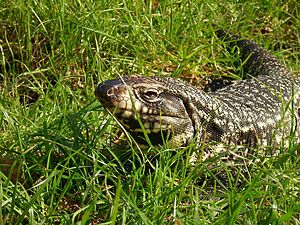Black and white tegu
| Black and white tegu | ||||||||||||
|---|---|---|---|---|---|---|---|---|---|---|---|---|

Black and white tegu ( Salvator merianae ) |
||||||||||||
| Systematics | ||||||||||||
|
||||||||||||
| Scientific name | ||||||||||||
| Salvator merianae | ||||||||||||
| ( Duméril & Bibron , 1839) |
The black and white Teju ( Salvator merianae , Syn . : Tupinambis merianae ) is a lizard from the family of the rail lizards (Teiidae).
description
The black and white Teju reaches a length of up to 1.70 meters and a weight of up to ten kilograms. However, it usually reaches five feet and about seven kilograms. The wild S. merianae has a greater proportion of black in color than the animals from breeding farms, with the top of the head being olive-green in juvenile age. This coloring is used for camouflage, as they fit into the prey scheme of many predators as young animals .
Black and white Tejus dig their sleeping / living caves, which are usually housed together in the winter time and usually separately in the rest of the time. They are less territorial, but travel up to 25 kilometers per week to forage. Because of this nomadic behavior, the male specimens rarely have problems with other males. Only the females tend to be extremely aggressive towards both sexes if they have been successfully mated.
In the pattern on the back there is most likely a highlighted white dotted line left and right from the head to the pelvis. Otherwise, as with most types of tea, mixed cross bands with light and dark spots. It has a powerful tail that it uses as a weapon against enemies. The teeth are basically similar to those of dogs, around a third smaller in proportion and almost completely covered with gums. Bites are painful from sharp teeth and pressure from the jaws, and they can leave gaping wounds. From wild black and white Tejus they can end up with blood poisoning , because the Tejus are scavengers and the germs can be detected in the saliva for a long time.
Some features of the Teju, such as the long snout and forked tongue , are reminiscent of monitor lizards; in fact, there is no closer relationship.
His strong extremities end in sharp and strong claws , which he uses for climbing and digging his living caves. Depending on the area of distribution, it hibernates for four to six months. The black and white Teju has a life expectancy of 15 to 20 years.
captivity
In captivity, these reptiles are extremely curious and quickly adapt to the habits of the keeper. They set their internal clock after meals and become tame as long as they have regular physical contact (handling) with the carer. They say they watch people and follow them too. There are also experiments with dog trainers (clickers), which are used to gain attention and through which the animals recognize that the keeper is moving. They often follow him in the experiments (Sisco & Varnyard).
Agricultural value
The Teju is kept on farms and in breeding operations and serves in South America as an important supplier of raw materials for the leather industry, where belts, boots, watch straps etc. are made from its skin. Ä. Manufactured and achieve high prices as an exotic product. His meat can also be found on the national menu.
distribution
Its natural range extends over large parts of South America . It is particularly widespread in Argentina , Paraguay , Uruguay (Lagarto) and Brazil and is the dominant fauna specimen in adulthood. It is mostly at home in the savannah and open grasslands and mostly sleeps in the undergrowth .
food
The black and white tegu has a wide range of foods . In addition to insects , amphibians and small lizards , it also eats fruit . But also eggs , poultry and carcasses can be accepted. He has been observed to forage primarily in the early hours of the morning. He grabs larger prey with a strong bite , shakes them until they are dead, and tears them into bite-sized pieces. If the prey is bite-sized, it is devoured whole.
Reproduction
The black and white tegu lays its eggs under piles of leaves. The clutch consists of up to 65 eggs. The young hatch after around 130 days. The young animals are on their own from the first day of life.
literature
- Gunther Koehler, Bert Langerwerf: Tejus. Way of life care breeding. Herpeton, Offenbach 2000, ISBN 3-9806214-3-X .
Individual evidence
Web links
- Salvator merianae in The Reptile Database
- Salvator merianae inthe IUCN Red List of Threatened Species 2013.2. Posted by: Embert, D., Fitzgerald, L. & Waldez, F., 2009. Retrieved January 30, 2014.
- DGHT
- teju.info
- Bert Langerwerf: Keeping and Breeding the Argentine Black and White Tegu. Archived from the original on August 19, 2010 ; Retrieved December 8, 2013 .
- Wild Great Tejus in Uruguay (2 video clips)